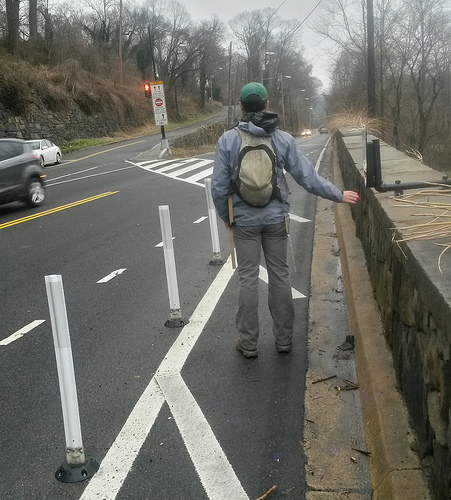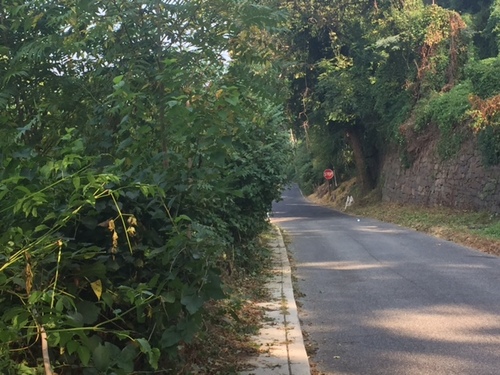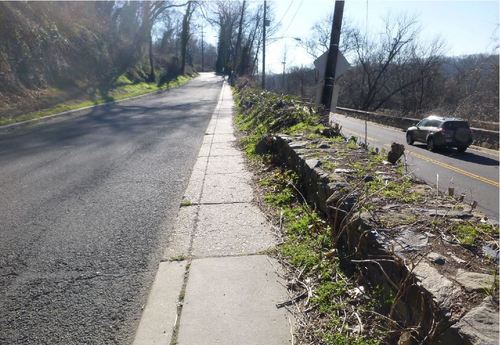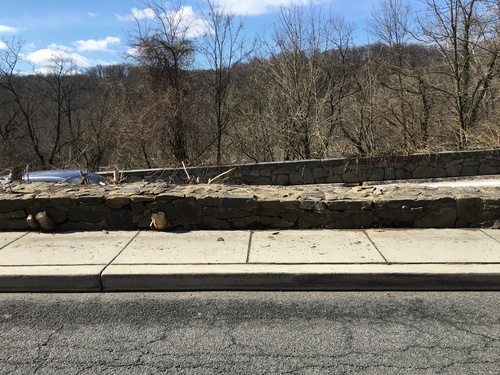How urban foresters made Canal Road’s new traffic signal way more useful

This sidewalk used to be covered in growth that made it nearly impossible to walk. Image by the author.
In December, a traffic signal went up on Canal Road near Fletcher’s Boathouse, meaning there’s now a safe way for pedestrians and cyclists to cross that very recently did not exist. But if it weren’t for the work of DDOT’s urban foresters, a key sidewalk leading up to the crossing would still be totally useless.
Lots of the District’s 8,600 fishing license holders visit Fletcher’s to fish in the Potomac River or C&O Canal. It’s a popular place to rent bikes, boats, and canoes, and there are great places nearby to have a picnic or walk along the Canal.
For years, pedestrians and cyclists had no safe, direct route from the Palisades and adjacent neighborhoods to Fletcher’s Boathouse and the C&O Canal. For example, someone taking the D6 bus to MacArthur Road at U Street NW would have to walk the half mile down Reservoir Road, then bravely cross fast-moving traffic at an unsignalized intersection across Canal Road.

Canal Road and the Clara Barton Parkway form a barrier to pedestrian and cyclist access to the C&O Canal National Historic Park. The red dots represent existing crossing points, and green dots are existing parking lots. The more southern blue dot is where the new signal went in. Base image from Google Maps, with labels by Nick Keenan.
This changed this past December, when DDOT, in cooperation with the National Park Service, completed a crosswalk and traffic signal at Canal and Reservoir Road. The walk or bike ride across Canal Road became safe and feasible thanks to the crosswalk, a pedestrian or vehicle activated traffic signal, and marked areas for pedestrians to stand.
A recently unusable sidewalk near the new signal is back in action!
Even with the work on the new signal underway, the sidewalk along Reservoir Road could have been featured as abandoned urban infrastructure. The actual connection to the neighborhood had in some places completely disappeared. Brush, grass, vines and invasive trees had completely overgrown the sidewalk, and nearly all of the quarter mile sidewalk from V Street down to Canal Road had uncontrolled vegetation growth.
Anyone walking or cycling would need to use the street in many places because the sidewalk was so obstructed.
This past August, as the intersection project progressed, I contacted DDOT’s Urban Forestry Administration (UFA) and asked them if they could take a look at the sidewalk. UFA confirmed that the trees were in fact invasive and had not been intentionally planted. And from there, foresters from the agency set about restoring the sidewalk.
The first things to go were bushes and other vegetation along the sidewalk. Foresters also chopped down the numerous invasive trees that had grown between the sidewalk and retaining wall and, in some cases, in the wall itself. Stumps of up to 4” in diameter remained, but they were cut as low as possible. And, finally, foresters removed the leaves and soil that had accumulated over the years.
The traffic signal and other intersection improvements added a decades-in-the-making crossing to Canal Road for pedestrians and cyclists. It also makes things safer for the 58,000 drivers who turn down into Fletcher’s Cove each year. But the less well known efforts of DDOT’s urban foresters completed what pedestrians and cyclists really needed in order to make the connection useful.





